Medellín’s traffic is a downside of living in Medellín. Traffic in many parts of the city can be bad during rush hours. But we provide tips to avoid traffic in Medellín. In addition, traffic is reportedly is the biggest concern of expats living in the city.
Also, traffic can sometimes get bad at lunch time in some parts of the city. In addition, it’s possible to run into gridlock anytime of the day, especially if there is an accident or road construction.
The worst traffic in Medellín tends to be found in El Poblado and El Centro in my experience, having lived over eight years in the city. In addition, the roads going north and south tend to have more problems with gridlock plus a few going east and west like Oriental and Ferrocarril in El Centro.
Furthermore, there are more motorcycles than cars in Medellín. And the motorcycle drivers in the city can be crazy and aggressive. They weave in and out, pass on both sides and come down the middle between two lanes. In addition, it seems that motorcycle drivers don’t always follow traffic laws except they usually stop at red lights.
Traffic is one of the downsides of living in Medellín but there are many benefits including the climate, cost of living and good healthcare. I previously covered 27 reasons why I chose to live in Medellín.
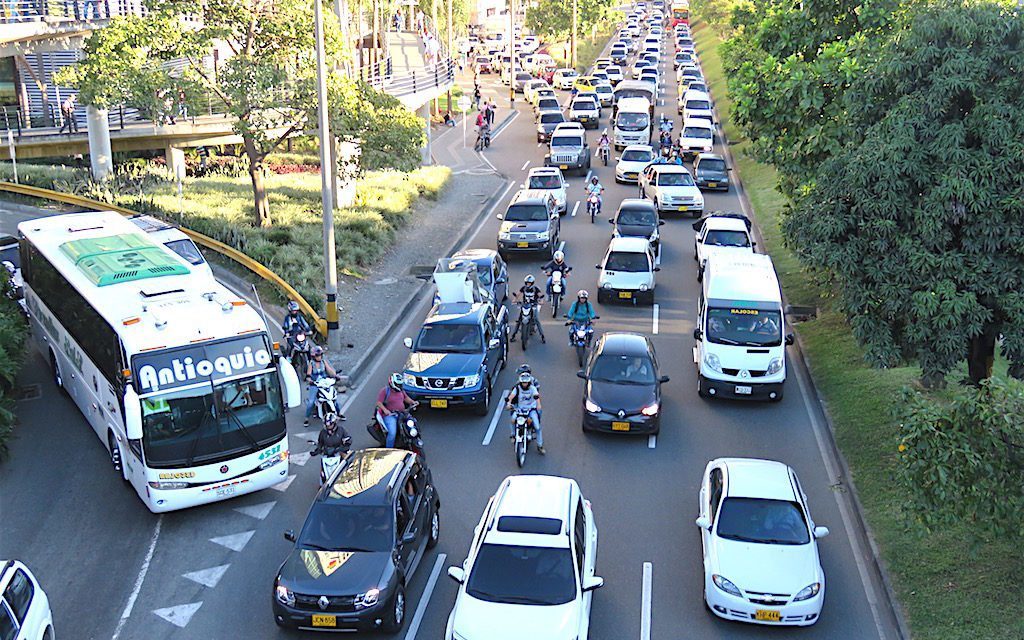
Near the Bancolombia headquarters in Medellín during rush hour
Medellín’s Traffic Problem
Colombia was ranked as one of the world’s worst places to drive in terms of driver satisfaction based on a study done by Waze. Colombia had several cities in that study that ranked as some of the worst in terms of traffic, including Bogotá (7th worst) and Medellín (8th worst).
But the traffic in Medellín isn’t so bad. It’s worse in Bogotá in my experience. Also, the much bigger cities of São Paulo and Mexico City have some of the worst gridlock found in Latin America.
Furthermore, between 2005 and 2015, the number of vehicles in the Aburrá Valley increased 182 percent from 478,000 in 2015 to 1.35 million in 2015.
The biggest increase from 2005 to 2015 was in motorcycles, which increased 411 percent from 139,000 motorcycles in 2005 to 710,186 motorcycles in 2015.
With all this growth in vehicles and motorcycles, road building and expansions haven’t kept up, resulting in increased traffic in the metro area.
In addition, a Destination Survey of the Metropolitan Area in 2012, which is the most recent study available, found that vehicle congestion increased the average time of a trip in Medellin to 34 minutes. This was 36 percent more time than a similar survey in 2005, when the average was 25 minutes.

Traffic in El Centro in Medellín
What is Medellín Doing About the Traffic Problem?
In 2009, the city of Medellín started investing millions of dollars in a high-tech road monitoring system. This system includes two nerve centers, which enable monitoring of traffic by a network of cameras and closed-circuit video feeds.
One of the nerve centers is the control center, where a team of agents collect and analyze a continuous stream of real-time data from the city’s roads. When an abnormality occurs, the agents decide what action to take.
The second nerve center is the Photo-Detection Center, which uses cameras and sensors to monitor many traffic hotspots and identify traffic infractions. The center identifies up to 6,000 potential offenses each day, which are corroborated by police officers.
The Secretaría de Movilidad in Medellín also has a development plan for the period from 2016 to 2019 which include 402 projects, many of which are road expansion projects.
In addition, the city has been expanding the Medellín metro. The latest expansion is the new M Metrocable line that recently opened, which is the fifth cable car system. Also, the city is expending the Encicla bike lending system. The city is trying to encourage the use of public transport systems that are also less polluting than cars and motorcycles.

Pico y Placa, photo courtesy of Secretará de Movilidad de Medellín
Pico y Placa – A Rush-Hour Rationing System to Reduce Traffic
Medellín has a pico y placa rationing system that was implemented to address the vehicle congestion problem in the city during rush hour. Pico y placa is a rush-hour road-space rationing system used on Monday to Friday.
Under pico y placa you are restricted from driving in Medellín during the rush hours on Monday to Friday from 7:00-8:30 am and from 5:30-7:00 pm depending on the last digit on a license plate for cars and the first digit of license plates for motorcycles.
Starting on February 4, 2018, the pico y placa restriction applies for cars with plates ending with the digit:
- Monday: 6, 7, 8, 9
- Tuesday: 0, 1, 2, 3
- Wednesday: 4, 5, 6, 7
- Thursday: 8, 9, 0, 1
- Friday: 2, 3, 4, 5
And for two-stroke motorcycles the restriction applies with plates starting with the digit:
- Monday: 4, 5
- Tuesday: 6, 7
- Wednesday: 8, 9
- Thursday: 0, 1
- Friday: 2, 3
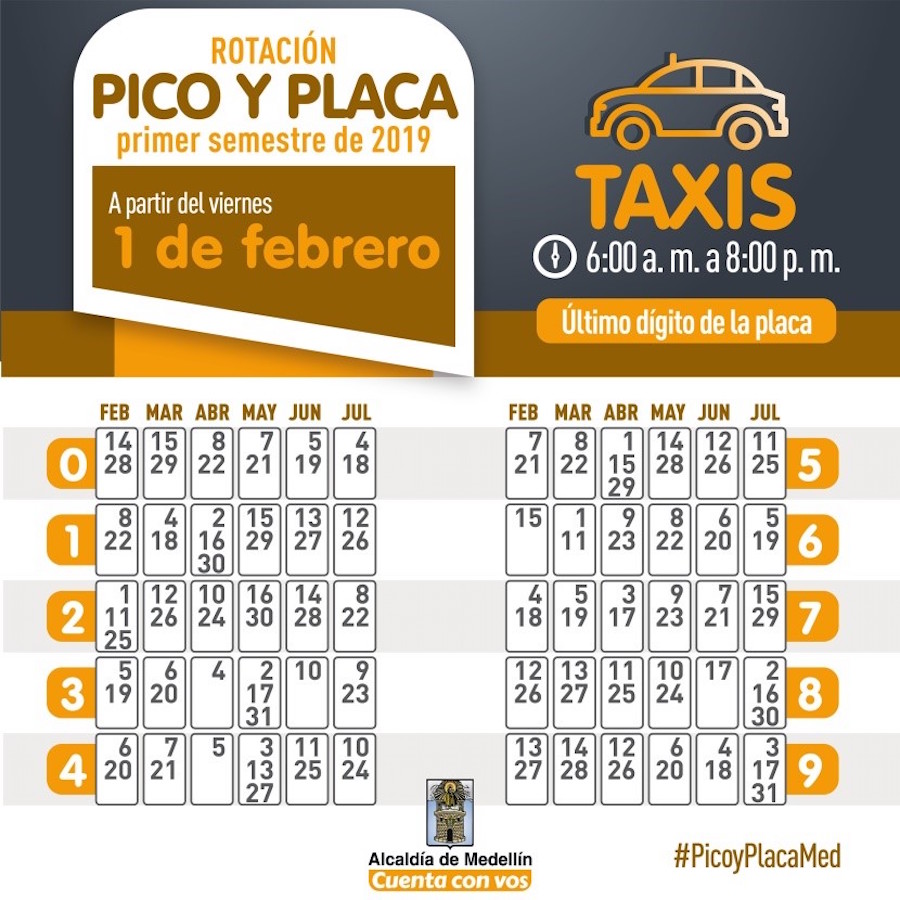
Pico y Placa for taxis, photo courtesy of Secretará de Movilidad de Medellín
Also, there is pico y placa rationing system for taxis. This system for taxis restricts driving from 6 am to 8 pm in Medellín anywhere from one to three days per month based on the last digit of a taxi license plate.
But some wealthy people in Medellín reportedly have two cars as a way to avoid pico y placa.

February 2019 vehicle restrictions due to pollution, courtesy of Area Metropolitana Valle de Aburrá
Medellín Can Restrict Vehicles During Times with High Pollution
Medellín has a major problem with pollution during two times of the year during the transition from the dry season to the rainy season. Every time there is a transition between the dry and rainy seasons, clouds prevent the particulate material PM2.5, which is harmful to health, from being released into the atmosphere
So, the 10 municipalities in February 2019 have entered into a state of prevention due to the quality of the air that is breathed in the Aburrá Valley during this time of year. The above restrictions go into effect on Monday, February 18, 2019.
The restriction based on license plates is for private vehicles, freight vehicles, two and four-stroke motorcycles. The schedule in which the restriction is in effect in the 10 municipalities of the Medellín metropolitan area is in the mornings from 7:00 to 8:30 am and in the afternoons from 5:30 pm to 7:00 pm.
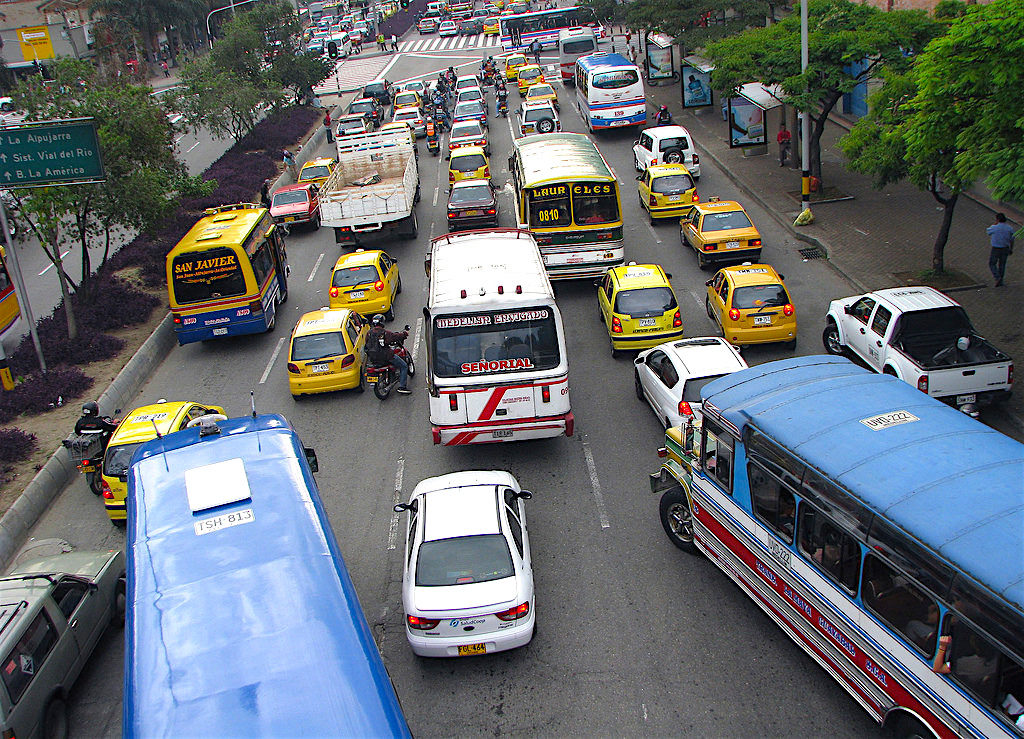
El Centro in Medellín during rush hour, photo by Bruno Aragaki
Tips for Avoiding Traffic in Medellín
We have four main tips for avoiding traffic in Medellín:
Avoiding Traffic Tip #1 – Learn When Traffic is the Worst
Our first tip to avoiding traffic is learn when traffic is the worst and try to avoid trips during this time. And adjust your schedule to avoid the peak gridlock times.
In my experience living over eight years in Medellín, the traffic tends to be worse during the evening rush hour than during the morning rush hour. So, I try to avoid all trips between about 5 pm to 7:30 pm.
Also, traffic can get bad during lunch hour, particularly in El Poblado and El Centro.
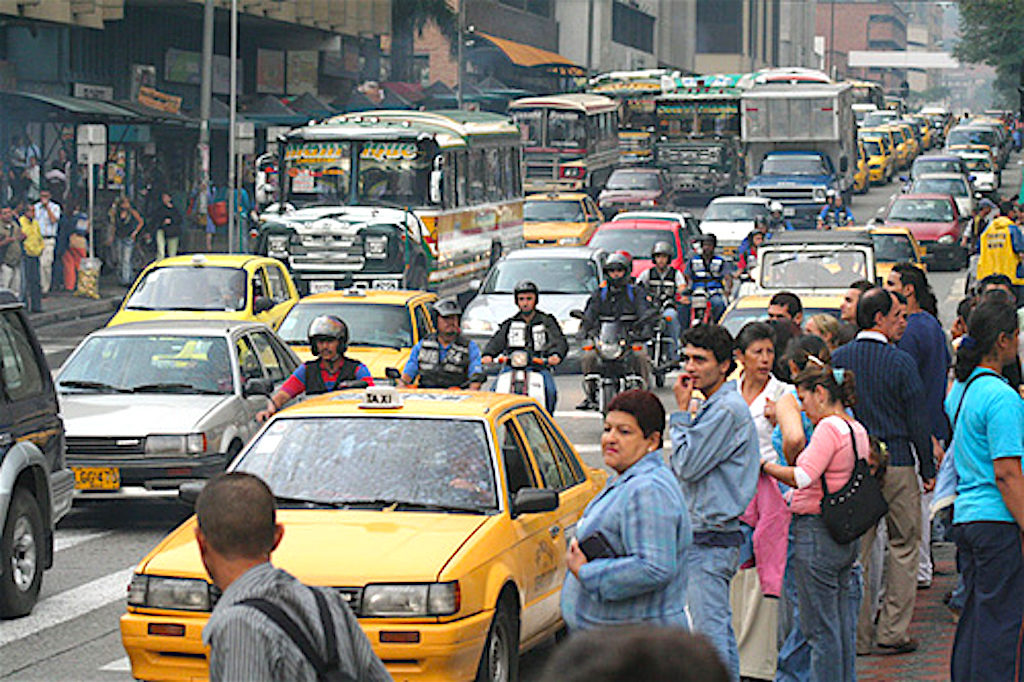
Traffic in El Centro in Medellín, photo by Antonio Jiménez
Avoiding Traffic Tip #2 – Learn Alternate Routes
Traffic jams can evolve when you drive like when there is an accident. So, it is good to know alternate routes.
Since I have lived over eight years in Medellín, I know many alternate routes to get places. But keep in mind that alternate routes can clog up fast. Sometimes it might be wiser to stick with the main road. The best way to know if an alternate route is faster is by using a mobile app, which is our next tip.

Waze App, courtesy of Waze
Avoiding Traffic Tip #3 – Use Waze
Waze is a maps mobile app that is popular in Medellín and Colombia. We included Waze in our list of the 20 best mobile apps to use in Medellín and Colombia. Waze is available for free on Android and iPhone.
I have started using Waze more often than Google Maps for use in cars. Waze has a large community of drivers feeding data into the app’s backend. So, Waze is able to better estimate travel times and also find alternate routes to avoid traffic.
The Waze map has real-time color-coded traffic that is normally more accurate than Google Maps. And I have used the alternate routes feature of Waze all the time to find faster routes while in taxis.
For example, I used this app six times in the past week to direct taxi drivers to alternate routes which were faster as they avoided traffic.
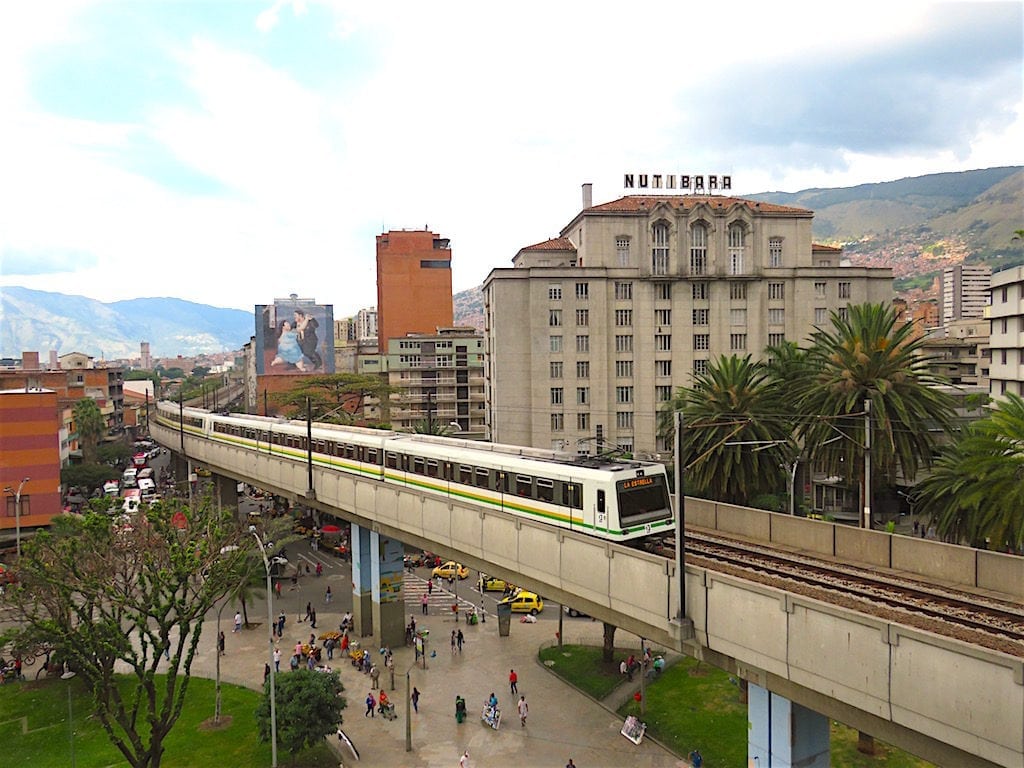
The Medellín Metro in El Centro
Avoiding Traffic Tip #4 – Use the Medellín Metro
If Medellín didn’t have the comprehensive Medellín Metro system, the traffic problem in Medellín would be much worse. While not perfect, the metro system in Medellín can save you time and also money. Also, you can read a book or the news when on the metro.
In 2018, the Medellín metro transported over 298 million passengers, which was an increase of 3.8 percent from 2017. Also, the metro system is heavily used by women. Last year, 57 percent of the metro passengers were women and 43 percent were men.
I use the metro system frequently as an alternative to taxis or buses and a way to avoid gridlock in the city. I have found there are many places in the city I can go faster by metro compared to taking a taxi or by bus on the busy roads.
From our apartment in Sabaneta it takes about 30 minutes by taxi to Santafé mall in El Pobaldo when there is no traffic. But this can take over an hour during rush hour.
By metro including walking it takes me only 40-45 minutes to get to Santafé mall. So, during rush hour using the metro is the fastest way for me to get to El Poblado and it’s also much cheaper than by taxi.
The Bottom Line: Medellín Traffic
Traffic is a downside of living and Medellín and can be bad at times. But it’s possible to avoid much of the traffic in the city if you follow our tips. Also, the gridlock is much worse in my experience in bigger cities like Bogotá, São Paulo and Mexico City.
What do readers think of Medellín’s traffic problem?
Sign up for the Free Medellin Guru Newsletter – You can see all of the previous Medellin Guru weekly email newsletters and sign up here.

